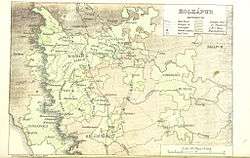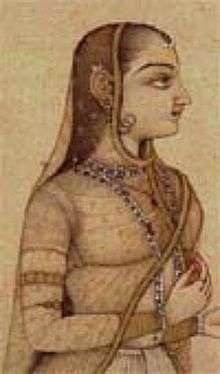Kolhapur State
| Kolhapur State कोल्हापूर रियासत | ||||||
| Princely State of British India | ||||||
| ||||||
| ||||||
 | ||||||
| History | ||||||
| • | Established | 1710 | ||||
| • | Independence of India | 1947 | ||||
| Area | ||||||
| • | 1901 | 8,332 km2 (3,217 sq mi) | ||||
| Population | ||||||
| • | 1901 | 910,011 | ||||
| Density | 109.2 /km2 (282.9 /sq mi) | |||||
| Today part of | Maharashtra, India | |||||
| | ||||||

Kolhapur State or Kolhapur Maratha Kingdom (1710–1949) was a Maratha princely State of British India, under the Deccan Division of the Bombay Presidency, and later the Deccan States Agency.[1] It was considered the most important of the Maratha principalities among with the other being Baroda State, Gwalior State and Indore State. Its rulers, of the Bhonsle dynasty, were entitled to a 19-gun salute - thus Kolhapur was also known as a 19-gun State. The state flag was a swallow-tailed orange pennant.[2]
History



Kolhapur State, together with its jagirs or feudatory vassal estates (including Ichalkaranji), covered an area of 3,165 square miles (8,200 km²). According to the 1901 census, the state population was 910,011, of which 54,373 resided in Kolhapur Town. In 1901, the state enjoyed an estimated revenue of £300,000.[3]
The Maharajas of Kolhapur have a common ancestry with the Bhonsle dynasties of Tanjore and Satara, claiming descent from the Maratha royal clan Bhonslà. The states of Satara and Kolhapur came into being in 1707, because of the succession dispute over the Maratha kingship. Shahuji, the heir apparent to the Maratha kingdom, captured by the Mughals at the age of nine, remained their prisoner at the death of his father Sambhaji, the elder son of Shivaji Maharaj the founder of the Maratha Empire in 1689. The Dowager Maharani Tarabai (a widow of Rajaram Chhatrapati, younger son of Shivaji Maharaj) proclaimed her son Shivaji I, as Chhatrapati Maharaj under her regency. The Mughals released Shahu under certain conditions in 1707, and he returned to claim his inheritance. He defeated the regent at the Battle of Khed and established himself at Satara, forcing her to retire with her son to Kolhapur. By 1710 two separate principalities had become an established fact. Shivaji II and Tarabai were soon deposed by the other widow of Rajaram, Rajasbai. She installed her own son, Sambhaji II as the new ruler of Kolhapur. Sambhaji II signed the Treaty of Warana in 1731 with his cousin Shahu to formalize the two separate seats of Bhonsle family. The British sent expeditions against Kolhapur in 1765 and 1792; Kolhapur entered into treaty relations with the British, after the collapse of the Maratha confederacy in 1812. In the early years of the 19th century the British invaded again, and appointed a political officer to temporarily manage the state.[4]
The last ruler of Kolhapur was HH Maharaja Chhatrapati Shahaji II. After Indian independence in 1947, Kolhapur acceded to the Dominion of India on 14 August 1947 and merged into Bombay State on 1 March 1949. In 1960 Bombay state was divided by languages into the states of Maharashtra and Gujarat. [5] The boundaries of former Kolhapur state correspond very closely with those of modern-day Kolhapur district in Maharashtra state.
Rulers of Kolhapur
Rajas
- 1710 - 2 Aug 1714 Shivaji II (b. 1696 - d. 1726)
- 2 Aug 1714 - 18 Dec 1760 Sambhaji II (b. 1698 - d. 1760)
- 20 Dec 1760 - 17 Feb 1773 Rani Jiji Bai (f) -Regent(b. 1716 - d. 1773)
- 22 Sep 1762 - 24 Apr 1813 Shivaji III(b. 1756 - d. 1813)
- 24 Apr 1813 - 2 Jul 1821 Sambhaji III (b. 1801 - d. 1821)
- 2 Jul 1821 - 3 Jan 1822 Shivaji IV (b. 1816 - d. 1822)
- 2 Jul 1821 - 3 Jan 1822 Shahaji -Regent (b. 1802 - d. 1838)
- 3 Jan 1822 - 29 Nov 1838 Shahaji
- 29 Nov 1838 - 4 Aug 1866 Shivaji V (b. 1830 - d. 1866)
- 29 Nov 1838 - 1845 Rani Sai Bai (f) -Regent (d. 1861)
- 4 Aug 1866 - 30 Nov 1870 Rajaram II Nagaji Rao (b. 1850 - d. 1870)
- 30 Nov 1870 - 12 Oct 1871 Rani Tara Bai (f) -Regent (b. 1855 - d. 1874)
- 12 Oct 1871 - 25 Dec 1883 Shivaji VI Chhatrapati Narayana Rao (b. 1863 - d. 1883)
- 25 Dec 1883 - 17 Mar 1884 Rani Anand Bai (f) -Regent
- 17 Mar 1884 - 1900 Shahu I Chhatrapati Jashwant (b. 1874 - see below)
Maharajas
- 1900 - 6 May 1922 Shahu I Chhatrapati Jashwant (see above; d. 1922)
- 17 Mar 1884 - 20 Mar 1885 Jaisinhrao Ghatge -Regent
- 6 May 1922 - 26 Nov 1940 Rajaram III Chhatrapati (b. 1897 - d. 1940)
- 26 Nov 1940 - 18 Nov 1942 Tara Bai (f) -Regent (1st time) (b. 1904 - d. ....)
- 18 Nov 1942 - 28 Sep 1946 Shivaji VII Chhatrapati (b. 1941 - d. 1946)
- 22 Nov 1942 - 31 Mar 1947 Tara Bai (f) -Regent (2nd time) (s.a.)
- 31 Mar 1947 - 15 Aug 1947 Shahaji II Chhatrapati (b. 1910 - d. 1983)
- 1983 - 20?? Shahu II Chhatrapati (b. 1948 – present)
Family tree
- Kalojirao Bhonsle
- Malojirao (1552-1606/20/22)
- Shahajirao (c1594-1664)
 SHIVAJI The Great, Emperor of the Maratha Empire (c1630-1680; Emperor: 1674-1680)
SHIVAJI The Great, Emperor of the Maratha Empire (c1630-1680; Emperor: 1674-1680)
 Shambhaji, Emperor of the Maratha Empire (1657-1689; r. 1680-1689)
Shambhaji, Emperor of the Maratha Empire (1657-1689; r. 1680-1689) Rajaram, Emperor of the Maratha Empire (1670-1700; r. 1689-1700)
Rajaram, Emperor of the Maratha Empire (1670-1700; r. 1689-1700)
 I. Shivaji I, Raja of Kolhapur (1696-1726; Raja of Kolhapur: 1710-1714)
I. Shivaji I, Raja of Kolhapur (1696-1726; Raja of Kolhapur: 1710-1714) II. Shambhaji I, Raja of Kolhapur (1698-1760; r. 1714-1760)
II. Shambhaji I, Raja of Kolhapur (1698-1760; r. 1714-1760)
- Sharifjirao
- Trimbukjirao
- Venkatjirao
- Mankojirao
- Shahajirao
 III. Shivaji II, Raja of Kolhapur (1756-1813; r. 1762-1813)
III. Shivaji II, Raja of Kolhapur (1756-1813; r. 1762-1813)
 IV. Shambhaji II, Raja of Kolhapur (1801-1821; r. 1813-1821)
IV. Shambhaji II, Raja of Kolhapur (1801-1821; r. 1813-1821)
-
 V. Shivaji III, Raja of Kolhapur (1816-1822; r. 1821-1822)
V. Shivaji III, Raja of Kolhapur (1816-1822; r. 1821-1822)
-
-
 VI. Shahaji I, Raja of Kolhapur (1802-1838; r. 1822-1838)
VI. Shahaji I, Raja of Kolhapur (1802-1838; r. 1822-1838)
 VII. Shivaji IV, Raja of Kolhapur KCSI (1830-1866; r. 1838-1866)
VII. Shivaji IV, Raja of Kolhapur KCSI (1830-1866; r. 1838-1866)- Shrimati Akhand Soubhagyavati Aubai Patankar m. (1845) Shrimant Sardar Ramchandrarao Patankar, Patil of Patan
-
 VIII. Rajaram I, Raja of Kolhapur (1850-1870; r. 1866-1870)
VIII. Rajaram I, Raja of Kolhapur (1850-1870; r. 1866-1870)
-
- Shrimati Akhand Soubhagyavati Balabai Maharaj Ghatge (d. 1867), m. (1848) Meherban Shrimant Chiranjiva Rajashri Narayanrao Ghatge, Sarjerao, Chief of Kagal Junior (c. 1833-1881)
- HH Meherban Shrimant Rajamanya Rajashri Jaisinhrao Ghatge, Sarjerao, Vazarat, Ma-ab, Chief of Kagal Senior (1857–1885) m. (2nd; 1878) Shrimant Akhand Soubhagyavati Radhabai Sahib Ghatge
-
 X. Shahu I, Maharaja of Kolhapur GCSI, GCIE, GCVO (1874-1922; r. 1884-1922; Raja of Kolhapur: 1884; Maharaja of Kolhapur: 1900)
X. Shahu I, Maharaja of Kolhapur GCSI, GCIE, GCVO (1874-1922; r. 1884-1922; Raja of Kolhapur: 1884; Maharaja of Kolhapur: 1900)
- HH Shrimant Akhand Soubhagyavati Maharani Radhabai Maharaj Puar, Maharani of Dewas Senior (1894–1973) m. (1908) HH Tukojirao III, Maharaja of Dewas Senior KCSI (1888–1937)
-
 XIII. Shahaji II, Maharaja of Dewas Senior, Maharaja of Kolhapur GCSI (1910-1983; Maharaja of Dewas Senior: 1937-1947; Maharaja of Kolhapur: 1947-1949; titular ruler: 1949-1971; family head: 1971-1983)
XIII. Shahaji II, Maharaja of Dewas Senior, Maharaja of Kolhapur GCSI (1910-1983; Maharaja of Dewas Senior: 1937-1947; Maharaja of Kolhapur: 1947-1949; titular ruler: 1949-1971; family head: 1971-1983)
- Shrimant Akhand Soubhagyavati Maharajkumari Shaliniraje Sahib Maharaj Bhonsle (b.1929) m. (1945)Shrijut Raje Rajaramsinhrao Laxmanrao Bhonsle (d. 1970)
- XIV. Shahu II, Maharaja of Kolhapur (b. 1948; family head: 1983-present)
- Shrimant Akhand Soubhagyavati Maharajkumari Shaliniraje Sahib Maharaj Bhonsle (b.1929) m. (1945)Shrijut Raje Rajaramsinhrao Laxmanrao Bhonsle (d. 1970)
-
-
 XI. Rajaram II, Maharaja of Kolhapur GCSI, GCIE (1897-1940; r. 1922-1940)
XI. Rajaram II, Maharaja of Kolhapur GCSI, GCIE (1897-1940; r. 1922-1940)
- HH Shrimant Akhand Soubhagyavati Maharani Radhabai Maharaj Puar, Maharani of Dewas Senior (1894–1973) m. (1908) HH Tukojirao III, Maharaja of Dewas Senior KCSI (1888–1937)
-
- HH Meherban Shrimant Rajamanya Rajashri Jaisinhrao Ghatge, Sarjerao, Vazarat, Ma-ab, Chief of Kagal Senior (1857–1885) m. (2nd; 1878) Shrimant Akhand Soubhagyavati Radhabai Sahib Ghatge
- Shambhajirao
- Ramchandrarao
- Narayanjirao
- Dinkarrao (b. 1832)
-
 IX. Shivaji V, Raja of Kolhapur KCSI (1863-1883; r. 1871-1883)
IX. Shivaji V, Raja of Kolhapur KCSI (1863-1883; r. 1871-1883)
-
- Dinkarrao (b. 1832)
- Narayanjirao
- Ramchandrarao
- Swarupjirao
- Mankojirao
- Yashwantrao (1832–1884)
- Appa Sahib
- Shivajirao
- Shankarrao (b. 1922)
-
 XII. Shivaji VI, Maharaja of Kolhapur (1941-1946; r. 1941-1946)
XII. Shivaji VI, Maharaja of Kolhapur (1941-1946; r. 1941-1946)
-
- Shankarrao (b. 1922)
- Shivajirao
- Appa Sahib
- Yashwantrao (1832–1884)
- Mankojirao
- Shahajirao
- Mankojirao
- Venkatjirao
- Trimbukjirao
- Shahajirao (c1594-1664)
- Malojirao (1552-1606/20/22)
See also
- Maratha
- Maratha Empire
- List of Maratha dynasties and states
- List of princely states of British India (alphabetical)
- Maharajas of Kolhapur
- Panhala Fort
References
- ↑ "Kolhapur State". The Imperial Gazetteer of India, Vol. 15. Oxford at Clarendon Press. 1909. pp. 380–87.
- ↑ Gazetteer, p. 380
- ↑ Kolhapur Princely State (19 gun salute)
- ↑ Manohar Malgonkar, Chhatrapatis of Kolhapur, Pub. Popular Prakashan, 1971.
- ↑ Princely States of India
- ↑ Satara (Bhonsle) - family genealogy
- ↑ Kolhapur (Bhonsle) - family genealogy
External links
 Media related to Kolhapur State at Wikimedia Commons
Media related to Kolhapur State at Wikimedia Commons- Kolhapur History and Genealogy royalark
- Mumbai and Princely States Heraldry
Coordinates: 16°41′N 74°14′E / 16.683°N 74.233°E


